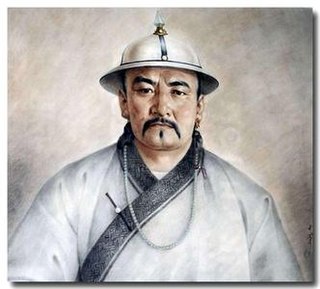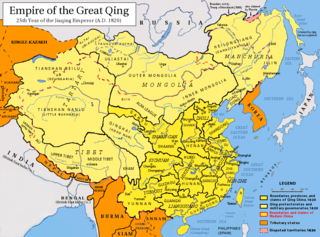
The Mongols are an East Asian ethnic group native to Mongolia, Inner Mongolia in China and the Buryatia Republic of the Russian Federation. The Mongols are the principal member of the large family of Mongolic peoples. The Oirats in Western Mongolia as well as the Buryats and Kalmyks of Russia are classified either as distinct ethno-linguistic groups or subgroups of Mongols.

The Kalmyks are a Mongolic ethnic group living mainly in Russia, whose ancestors migrated from Dzungaria. They created the Kalmyk Khanate from 1635 to 1779 in the south of the European part of Russia territory. Today they form a majority in Kalmykia, located in the Kalmyk Steppe, on the western shore of the Caspian Sea.
Narrative of the Chinese Embassy to the Khan of the Tourgouth Tartars, in the years 1712, 13, 14, and 15 is a record of the travel to Kalmykia, written by Tulišen, a Manchu official who lived in the Qing dynasty.
The Dzungar Khanate, also written as the Zunghar Khanate, was an Inner Asian khanate of Oirat Mongol origin. At its greatest extent, it covered an area from southern Siberia in the north to present-day Kyrgyzstan in the south, and from the Great Wall of China in the east to present-day Kazakhstan in the west. The core of the Dzungar Khanate is today part of northern Xinjiang, also called Dzungaria.

Oirats or Oirds, also formerly Eluts and Eleuths, are the westernmost group of the Mongols whose ancestral home is in the Altai region of Siberia, Xinjiang and western Mongolia.

The Khoshut are one of the four major tribes of the Oirat people. They established the Khoshut Khanate in the area of Tibet in 1642–1717.

Erdeniin Galdan, known as Galdan Boshugtu Khan was a Choros Dzungar-Oirat khan of the Dzungar Khanate. As fourth son of Erdeni Batur, founder of the Dzungar Khanate, Galdan was a descendant of Esen Taishi, the powerful Oirat Khan of the Northern Yuan dynasty who united all Mongols in the 15th century. Galdan's mother Yum Aga was a daughter of Güshi Khan, the first Khoshut-Oirat King of Tibet.
Tulišen was a Manchu official and diplomat during the early Qing dynasty.

The Torghut, Chinese: 土尔扈特, "Guardsman" are one of the four major subgroups of the Four Oirats. The Torghut nobles traced its descent to the Keraite ruler Tooril; also many Torghuts descended from the Keraites.
Erdeni Batur was a Choros-Oirat prince generally considered to be the founder of the Dzungar Khanate, centered in the Dzungaria region, currently in north-westernmost part of China.

The Dzungar people were the many Mongol Oirat tribes who formed and maintained the Dzungar Khanate in the 17th and 18th centuries. Historically, they were one of the major tribes of the Four Oirat confederation. They were also known as the Eleuths or Ööled, from the Qing dynasty euphemism for the hated word "Dzungar", and as the "Kalmyks". In 2010, 15,520 people claimed "Ööled" ancestry in Mongolia. An unknown number also live in China, Russia and Kazakhstan.
The Upper Mongols, also known as the Köke Nuur Mongols or Qinghai Mongols, are ethnic Mongol people of Oirat and Khalkha origin who settled around Qinghai Lake in so-called Upper Mongolia. As part of the Khoshut Khanate of Tsaidam and the Koke Nuur, they played a major role in Sino–Mongol–Tibetan politics during the 17th and 18th centuries. The Upper Mongols adopted Tibetan dress and jewelry despite still living in the traditional Mongolian ger and writing in the script.

The Kalmyk Khanate was an Oirat khanate on the Eurasian steppe. It extended over modern Kalmykia and surrounding areas in the North Caucasus, including Stavropol and Astrakhan. During their independence, the Kalmyks both raided and allied with Russia in turn, engaging in numerous military expeditions against the Crimean Tatars, the Ottoman Empire, neighboring Muslim tribes, and the highlanders of the North Caucasus. The Khanate was annexed by the Russian Empire in 1771.

The Dzungar genocide was the mass extermination of the Mongol Dzungar people by the Qing dynasty. The Qianlong Emperor ordered the genocide due to the rebellion in 1755 by Dzungar leader Amursana against Qing rule, after the dynasty first conquered the Dzungar Khanate with Amursana's support. The genocide was perpetrated by Manchu generals of the Qing army supported by Turkic oasis dwellers who rebelled against Dzungar rule.
The Dzungar conquest of Altishahr resulted in the Tibetan Buddhist Dzungar Khanate in Dzungaria conquering and subjugating the Genghisid-ruled Chagatai Khanate in Altishahr. It put a final end to the independence of the Chagatai Khanate.
Anti-Mongol sentiment has been prevalent throughout history, often perceiving the Mongols to be barbaric and uncivilized people with a lack of intelligence or civilized culture.
Tagtsepa Lhagyal Rabten was the regent of the Tibetan administration during the 3-year rule of the Dzungar Khanate in Tibet (1717–1720). He carried the Tibetan title sakyong. After the intervention by the troops of the Chinese Kangxi Emperor, he was executed by the Chinese on the charge of collaboration, thus began the period of Qing rule of Tibet.

The Qing dynasty in Inner Asia was the expansion of the Qing dynasty's realm in Inner Asia in the 17th and the 18th century AD, including both Inner Mongolia and Outer Mongolia, both Inner Manchuria and Outer Manchuria, Tibet, Qinghai and Xinjiang.

The Manchu-led Qing dynasty of China ruled over Xinjiang from the late 1750s to 1912. In the history of Xinjiang, the Qing rule was established in the final phase of the Dzungar–Qing Wars when the Dzungar Khanate was conquered by the Qing dynasty, and lasted until the fall of the Qing dynasty in 1912. The post of General of Ili was established to govern the whole of Xinjiang and reported to the Lifan Yuan, a Qing government agency that oversaw the empire's frontier regions. Xinjiang was turned into a province in 1884.

The Kazakh–Dzungar Wars (1643–1756) were a series of long conflicts between the Kazakh Juzes and Dzungar Khanate. The strategic goal for the Dzungars was to increase their territories by taking neighboring lands that were part of the Kazakh Khanate. The Dzungars were not only seen as a threat by the Kazakhs, but for the rest of Central Asia and the Russian Empire itself. Lama dorji and Amursana started internal conflict between Dzungar khanate. Qing used this as chance to invade Dzungars. When Qing army invaded Dzungars Kazakh khanate decided to invade them and regain lost lands to Dzungars when they are distracted by Qing. War ended when Qing dynasty annexed Dzungar khanate











